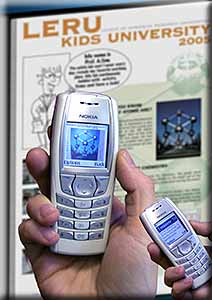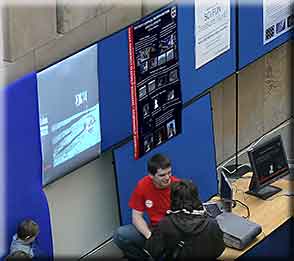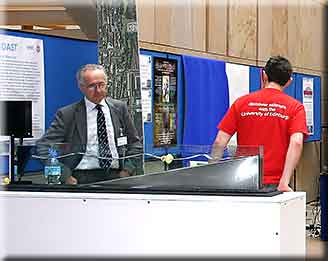|
|
Research Projects
|
|
| A tangential theme at this year's SCI-FUN Science Festival event was the way in which research is carried out at the University of Edinburgh, including those spin-off companies which emerge, using ideas developed within the university framework. The PP4SS project is, of course, an example of the way in which research work can be demonstrated to school pupils, as part of the more general aim of introducing a particular scientific field, but we also wanted to showcase the work of groups who have entered the commercial sphere. (We were also able to display, at short notice, some of the work carried out by other schools within Science and Engineering.) Below is a brief description of some of the exhibits and displays. |
|
Mobile Acuity – Spellbinder
|
|
One group, Mobile Acuity, used the Spellbinder package (described below, and in more detail at their website) to run a mobile phone treasure hunt as part of the SCI-FUN festival event. The hunt involved using picture messages containing clues for participants to track down, photograph, and then send to a server based at the Mobile Acuity office. The server analysed the received image, and attempted to match it to the known list of picture clues, using a variety of image-processing and manipulation techniques. If successful (and if the picture matched the current clue), the next clue was sent to the hunter.
We used the treasure hunt to help move people from the well-attended Hawthornden Court area (near the entrances to both museums) to the Science Zone, sited on the second (or fifth, depending on the museum frame of reference!) floor. (The Science Zone did, in the end, get large audiences, helped by the innovative science 'buskers' at the museum entrance.) Clues sent hunters from Hawthornden Court up to the PP4SS and Informatics exhibits, and then back down to the SCI-FUN area.
From the Mobile Acuity website:
"The Spellbinder technology allows any piece of digital content to be associated with an image of a real location. If the system is queried with an image of the same location then the digial content is returned. This core functionality enables applications to be developed where digital content can be distributed around real places and accessed by users with camera phones.
"Spellbinder enables new location based services and games where graphical digital content is precisely located in the real world. Spellbinder provides a new and compelling use for your camera phone, creates new application opportunities for developers and increases the use of picture messaging and data traffic for operators."
|
|
|
|
|
|
|
|
|
The Institute for Digital Communications, part of the School of Engineering and Electronics, supplied the "Segmentation for Motion Picture Special Effects" demonstration, seen opposite (in a picture clipped from the full-size Hawthornden panorama). The exhibit showed how objects (in this case the boy on the left) could be viewed by a camera and then superimposed on another scene (the moon's surface, as seen on the projected display); the software analysing the original image would remove all parts which matched a given colour, in this case the deep blue of the backdrop, and the cloth held by the boy to obscure every part of him but his head.
Lots of photographs were taken of children taking part in the recent "Ice Age 2" film...
|
|
|
The Acoustics and Fluid Dynamics Group kindly loaned us their wavetank (opposite) and associated graphics, which generated lots of interest (especially when there was a volunteer who could describe some of the principles involved in the formation of waves and their breaking on a shoreline. )
The School of Informatics (at very short notice) also provided us with three posters describing current research topics, as well as members of staff (including postgraduate students) who could discuss this research with interested members of the public.
Although in the 2006 Science Festival we didn't have time to develop more such links, this is part of what we would like to present in future festivals: a way for schools and departments to showcase current and cutting-edge research, with postgraduate students describing their work to the public.
|
|
|
|
| Agilent Technologies, who sponsor students in the School of Engineering and Electronics, provided an exhibit which demonstrated ways in which mobile phones can be tested, using a desktop phone network. Signal strength and quality could be varied and the response of the phone measured. |
|
|



